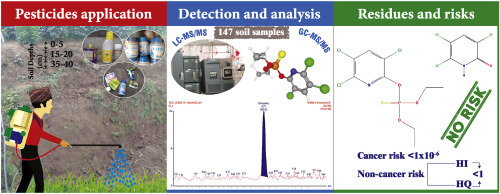当前位置:
X-MOL 学术
›
Chemosphere
›
论文详情
Our official English website, www.x-mol.net, welcomes your
feedback! (Note: you will need to create a separate account there.)
Concentration and distribution of pesticide residues in soil: Non-dietary human health risk assessment.
Chemosphere ( IF 8.1 ) Pub Date : 2020-03-27 , DOI: 10.1016/j.chemosphere.2020.126594 Govinda Bhandari 1 , Kishor Atreya 2 , Paul T J Scheepers 3 , Violette Geissen 4
Chemosphere ( IF 8.1 ) Pub Date : 2020-03-27 , DOI: 10.1016/j.chemosphere.2020.126594 Govinda Bhandari 1 , Kishor Atreya 2 , Paul T J Scheepers 3 , Violette Geissen 4
Affiliation

|
Soil contamination by pesticide residues is a primary concern because of the high soil persistence of pesticides and their toxicity to humans. We investigated pesticide concentration and distribution at 3 soil depths in 147 soil samples from agricultural land and assessed potential health risks due to non-dietary human exposure to pesticides in Nepal. About sixty percent of the soil samples had pesticides (25% of the soil samples had single residue, 35% of the soil samples had mixtures of 2 or more residues) in 39 different pesticide combinations. Pesticide residues were found more frequently in topsoil. Overall, the concentration of pesticides ranged from 1.0 μg kg-1 to 251 μg kg-1, with a mean of 16 μg kg-1. The concentration of the primary group, organophosphates (OPs), ranged from 1.23 μg kg-1 to 239 μg kg-1, with a mean of 23 μg kg-1. Chlorpyrifos and 3,5,6-trichloro-2-pyridinol (TCP) were the predominant contaminants in soils. The ionic ratio of DDT and its degradation products suggested a continuing use of DDT in the area. Human health risk assessment of the observed pesticides in soil suggested negligible cancer risks and negligible non-cancer risks based on ingestion as the primary route of exposure. The predicted environmental concentrations (PECs) of pesticides were higher than the values found in the guidance for soil contamination used internationally. Low concentrations of residues in the soils from agricultural farms practicing integrated pest management (IPM) suggest that this farming system could reduce soil pollution in Nepal.
中文翻译:

土壤中农药残留的浓度和分布:非饮食性人类健康风险评估。
由于农药在土壤中的高度持久性及其对人体的毒性,因此农药残留物对土壤的污染是一个主要问题。我们调查了来自农业土地的147个土壤样品中3种土壤深度处的农药浓度和分布,并评估了尼泊尔非饮食人类接触农药所引起的潜在健康风险。39种农药组合中,约有60%的土壤样品中有农药(25%的土壤样品中有单一残留物,35%的土壤样品中有2种以上残留物的混合物)。在表层土壤中发现农药残留的频率更高。总体而言,农药的浓度范围为1.0μgkg-1至251μgkg-1,平均为16μgkg-1。第一类有机磷酸酯(OPs)的浓度范围为1.23μgkg-1至239μgkg-1,平均为23μgkg-1。毒死rif和3,5,6-三氯-2-吡啶醇(TCP)是土壤中的主要污染物。滴滴涕及其降解产物的离子比表明该地区继续使用滴滴涕。对土壤中观察到的农药的人类健康风险评估表明,以摄入为主要暴露途径,基于摄入的癌症风险和非癌症风险均可以忽略。预测的农药环境浓度(PECs)高于国际上使用的土壤污染指南中的值。实行病虫害综合治理(IPM)的农业农场土壤中的残留物浓度低,表明这种耕作制度可以减少尼泊尔的土壤污染。滴滴涕及其降解产物的离子比表明该地区继续使用滴滴涕。对土壤中观察到的农药的人类健康风险评估表明,以摄入为主要暴露途径,基于摄入的癌症风险和非癌症风险均可以忽略。预测的农药环境浓度(PECs)高于国际上使用的土壤污染指南中的值。实行病虫害综合治理(IPM)的农业农场土壤中的残留物浓度低,表明这种耕作制度可以减少尼泊尔的土壤污染。滴滴涕及其降解产物的离子比表明该地区继续使用滴滴涕。对土壤中观察到的农药的人类健康风险评估表明,以摄入为主要暴露途径,基于摄入的癌症风险和非癌症风险均可以忽略。预测的农药环境浓度(PECs)高于国际上使用的土壤污染指南中的值。实行病虫害综合治理(IPM)的农业农场土壤中的残留物浓度低,表明这种耕作制度可以减少尼泊尔的土壤污染。预测的农药环境浓度(PECs)高于国际上使用的土壤污染指南中的值。实行病虫害综合治理(IPM)的农业农场土壤中的残留物浓度低,表明这种耕作制度可以减少尼泊尔的土壤污染。预测的农药环境浓度(PECs)高于国际上使用的土壤污染指南中的值。实行病虫害综合治理(IPM)的农业农场土壤中的残留物浓度低,表明这种耕作制度可以减少尼泊尔的土壤污染。
更新日期:2020-03-28
中文翻译:

土壤中农药残留的浓度和分布:非饮食性人类健康风险评估。
由于农药在土壤中的高度持久性及其对人体的毒性,因此农药残留物对土壤的污染是一个主要问题。我们调查了来自农业土地的147个土壤样品中3种土壤深度处的农药浓度和分布,并评估了尼泊尔非饮食人类接触农药所引起的潜在健康风险。39种农药组合中,约有60%的土壤样品中有农药(25%的土壤样品中有单一残留物,35%的土壤样品中有2种以上残留物的混合物)。在表层土壤中发现农药残留的频率更高。总体而言,农药的浓度范围为1.0μgkg-1至251μgkg-1,平均为16μgkg-1。第一类有机磷酸酯(OPs)的浓度范围为1.23μgkg-1至239μgkg-1,平均为23μgkg-1。毒死rif和3,5,6-三氯-2-吡啶醇(TCP)是土壤中的主要污染物。滴滴涕及其降解产物的离子比表明该地区继续使用滴滴涕。对土壤中观察到的农药的人类健康风险评估表明,以摄入为主要暴露途径,基于摄入的癌症风险和非癌症风险均可以忽略。预测的农药环境浓度(PECs)高于国际上使用的土壤污染指南中的值。实行病虫害综合治理(IPM)的农业农场土壤中的残留物浓度低,表明这种耕作制度可以减少尼泊尔的土壤污染。滴滴涕及其降解产物的离子比表明该地区继续使用滴滴涕。对土壤中观察到的农药的人类健康风险评估表明,以摄入为主要暴露途径,基于摄入的癌症风险和非癌症风险均可以忽略。预测的农药环境浓度(PECs)高于国际上使用的土壤污染指南中的值。实行病虫害综合治理(IPM)的农业农场土壤中的残留物浓度低,表明这种耕作制度可以减少尼泊尔的土壤污染。滴滴涕及其降解产物的离子比表明该地区继续使用滴滴涕。对土壤中观察到的农药的人类健康风险评估表明,以摄入为主要暴露途径,基于摄入的癌症风险和非癌症风险均可以忽略。预测的农药环境浓度(PECs)高于国际上使用的土壤污染指南中的值。实行病虫害综合治理(IPM)的农业农场土壤中的残留物浓度低,表明这种耕作制度可以减少尼泊尔的土壤污染。预测的农药环境浓度(PECs)高于国际上使用的土壤污染指南中的值。实行病虫害综合治理(IPM)的农业农场土壤中的残留物浓度低,表明这种耕作制度可以减少尼泊尔的土壤污染。预测的农药环境浓度(PECs)高于国际上使用的土壤污染指南中的值。实行病虫害综合治理(IPM)的农业农场土壤中的残留物浓度低,表明这种耕作制度可以减少尼泊尔的土壤污染。











































 京公网安备 11010802027423号
京公网安备 11010802027423号